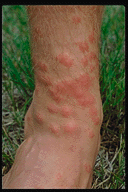Cercarial Dermatitis: What to Know about Treatment
Information mostly gathered from Stanford University. [email protected]
|
Thanks to Hope University |
Many people suffer from Cercarial dermatitis. If you're reading this, you may or may not know that this is an uncomfortable rash, the severity of which can range from a nuisance to interfering with normal activities. Minutes to hours after contact with cercariae infested water, a person may experience a prickling sensation or itchiness where cercariae penetrate the skin. Within 12 to 24 hours, a macular rash develops on the skin that was exposed to the water. Erythema (reddening of the skin) or urticaria may develop during this time. Next, the rash proceeds to maculopapular eruptions and may develop purpurtic lesions. The rash then proceeds to a vesicular state.
Often times, intense itchiness causes people to scratch, leading to ulceration of the vesicles. The rash may be further complicated by secondary bacterial infection. It is important to note that although human Schistosomiasis can cause a rash, it is not as severe and noticeable as that caused by avian or bovine cercariae. It has been reported that the cercariae S. masoni produces an anti-inflammatory agent that is absent in avian cercariae. One can speculate that the absence of this agent may contribute to the severity of the immune response that leads to cercarial dermatitis.
Here's what affects the severity of the dermatitis:
- Length of time in water: The longer a person spends in contaminated water, the higher the chances that the cercariae will penetrate the skin. Futhermore, the longer a person is exposed to water, the more times the skin is penetrated.
- Drying off after being in the water: Drying off immediately after one gets out of the water removes any cercariae on the surface of the skin that may attempt to enter the skin.
- Previous exposure: The maculopapular rash that characterizes cercarial dermatitis is essentially an immune response to the presence of the cercariae. The first exposure to cercariae produces a primary immune response, so the response may take longer to manifest into a rash. However, subsequent exposures lead to faster and more vigorous immune responses, leading to more pronounced symptoms. For example, in the early 20c. the Japanese koganbyo (lake side disease), which was common in the rice-growing district of Shinji Lake. Rice growing requires continuous labor in flooded fields, hence rice farmers are very vulnerable to cercarial dermatitis. Koganbyo is an extreme form of cercarial dermatitis leading such severe itching that it caused insomnia, extensive papules, swollen axillary or inguinal lymph glands and sloughing off of skin.
Cercarial Dermatitis - Diagnostic Tests
There are no readily available and easy tests for cercarial dermatitis. Diagnosis is based on a history of exposure to water that may be contaminated with cercariae. Other diagnostic methods used are capturing snails in areas where an outbreak occurs and testing their secretions to see if any cercariae are present. This, however, takes time. A quicker way to accomplish this is to crush snails and examine the remains for cercariae. Basically the most common methods for diagnosis require visualization of the cercariae using microscopy. During the early 20th century there was a skin test developed using parts of cercariae. However, the reaction to the skin test was very vigorous. This does not make sense to use for a disease that is self-limiting and not life threatening. Needless to say the skin test is not currently used to diagnose cercarial dermatitis.
Cercarial Dermatitis Treatment, Management & Therapy
Since cercarial dermatitis usually resolves by itself in 2-3 days, management involves symptomatic treatment. Topical anti-itch creams and antihistamines can help alleviate the intense itching that develops. For more severe cases, mild topical corticosteriods can help dampen the immune response and alleviate the rash. Home remedies such as cool compresses and bathing with baking soda are also recommended.
- How do you get Eczema?
- Infantile Seborrheic Dermatitis
- Dermatitis Herpetiformis Symptoms
- Mild Dermatitis Herpetiformis
- Foot Dermatitis Symtoms
- What is a Dermatologist?
- Perioral Dermatitis Toothpaste
- What is Dermatitis?
- Pyotraumatic Dermatitis
- Psoriasiform Dermatitis Treatment
- Psoriasis Vulgaris
- Eosinophilic Dermatitis Treatment
- Guttate Psoriasis
- Lichenoid Dermatitis Information
- Dermatitis Herpetiformis Images, Causes, Symptons, & Treatment
- Infantile Seborrheic Dermatitis vs. Eczema
- Rosacea: a Chronic Skin Condition
- What is an allergy?
- Protopic: Important Information about the Topical Immunosuppressant
- Psoriasis Wiki

